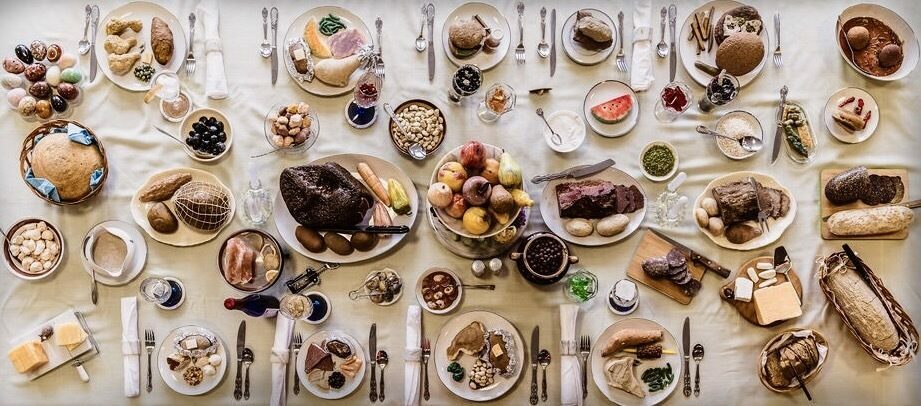The ‘Rock Food’ Feast That Looks Good Enough to Eat
Welcome to the world of rockhounds, pebble puppies, and a bizarre art installation almost 40 years in the making.
Source: Atlas Obscura, December 17, 2021, by Diana Hubbell. Used with permission of the author.

THE FEAST LOOKS SO LIFELIKE that more than a few gawkers over the years have tried to partake. Spread across the central table is a generous dinner for eight, complete with an immense ham made of petrified wood. In the bowl of fruit at the center sit prunes made of Apache tears, a round pebble form of obsidian, along with blueberries made from azurite. Hearty bowls of hominy consist of pearl slugs, iridescent wonders produced by mollusks in the dark mud of the Mississippi River. The pepper in the pepper shaker is ash from the 1980 eruption of Mount St. Helens. The tea in the porcelain tea cups is black volcanic sand from the beaches of Hawaii. Over on the dessert table, a hunk of fossilized shark vertebrae is a dead ringer for an oatmeal cookie. Sitting next to it, a box of gleaming gemstone truffles look too tempting to resist.
“We’ve had people in the past try to pick up food and bite into it, because it looks so real,” says Julia Toombs, secretary at the East Texas Gem and Mineral Society, which takes care of the collection. To fend off peckish onlookers and petty jewel thieves, a member of the society is always on guard whenever the Rock Food Table, as it’s come to be known, is on display.

It all started when a pair of rock collectors by the name of Bill and Lois Pattillo spotted an array of deceptively delicious-looking stones shaped like sweet rolls at a rock and gem shown 1982. The Pattillos realized they had a few such pieces in their own collection and decided to exhibit their own spread in their hometown of Corpus Christi, Texas. Since its public debut in 1983, the collection of eerily naturalistic dishes has grown across three tables, representing breakfast, dinner, and dessert.
As word spread, rock collectors from around Texas and beyond started reaching out with rocks to donate to this ever-expanding potluck. Today, there are 383 pieces in the collection, which continues to grow. The Rock Food Table has also racked up mileage, often in the back of Bill and Lois’s mobile home. To date, the collection has traveled to more than 40 cities around the country, covering more than 100,000 miles in the process. The Rock Food Table stayed with the Pattillos for 20 years, until 2014, when the couple sold it to Keith and Toni Harmon, who in turn donated it to the East Texas Gem and Mineral Society in 2017.

Humans have a longstanding obsession with gastronomic trompe l’oeils, whether they’re made out of plastic, polymer clay, or stone. One of the prized treasures of Taiwan’s National Palace Museum is a cabbage painstakingly carved from a single piece of green and white jadeite, complete with lifelike insects perched on the leaves. The priceless vegetable once belonged to a renowned Qing Dynasty consort.
What’s curious about the Rock Food Table is that, save for a few minor modifications here and there, the rocks are presented exactly as they were found, without any carving or etching done to make them look more edible. “The key lime pie looks like a slice of key lime pie, but you’ll notice it’s not a perfect triangle,” Tomb says. “That is displayed the way it was found. The block of cheese might have been evened off, but that’s actually the natural formation of calcite.”

For the 187 members of the East Texas Gem and Mineral Society, unraveling the mysteries of rock formations above and below the Earth’s surface is a lifelong passion. Ever since the society was founded in 1956, devotees have referred to themselves as “rockhounds.” Junior members earn the distinction of being “pebble puppies.”
The skilled mineralogists within the society can identify common rock-forming minerals and gems like feldspar or zoisite on sight, but the origins of few pieces of the Rock Food Table remain a mystery. Many of the original donors to the collection have passed away and a number of the handwritten records have been lost over the years, meaning tracking down the origins of the rocky pat of butter on a stone baked potato requires serious detective work. “I’ve always wanted to put together a sheet that said what everything is made of,” Toombs says. “But that would probably take more hours than I have left in my life.”
